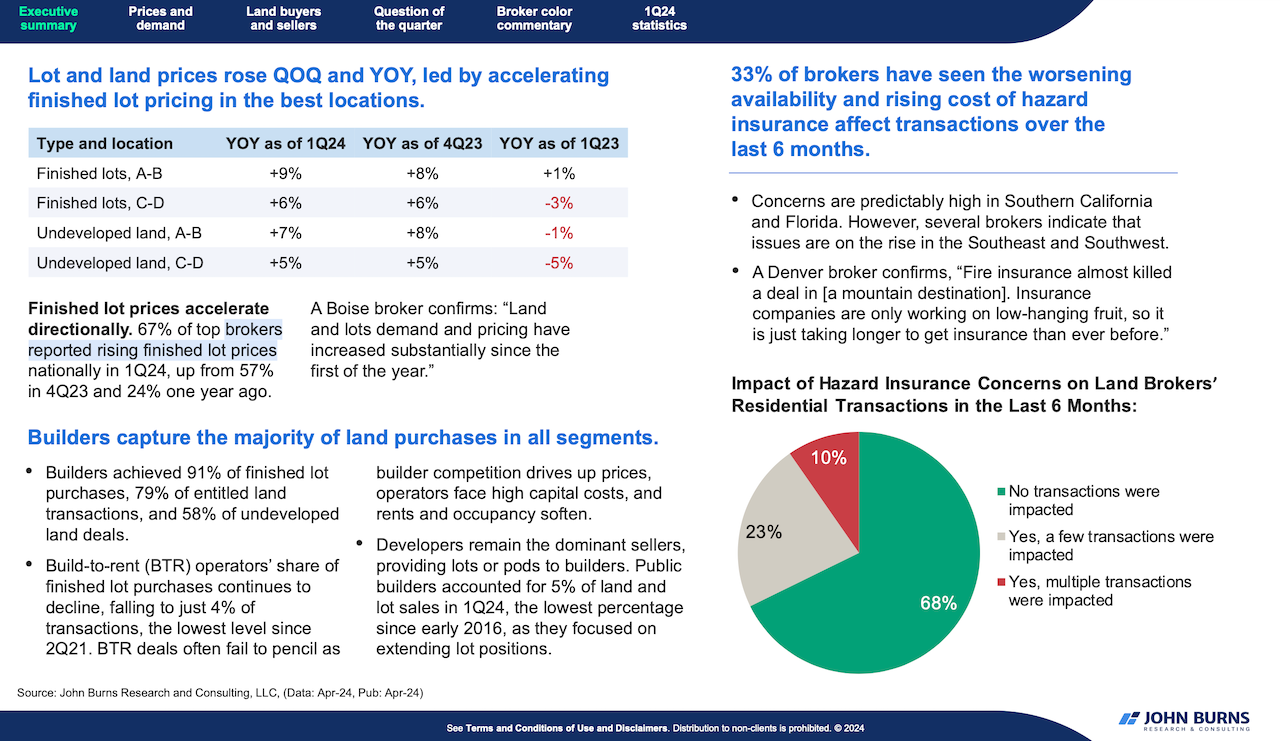Land
It's Always About Land In Homebuilding, But Now It's Different
Prices for it are high; multiple bidders for it strive to control it and build on it; borrowing costs to finance it are high, time-value-of-money costs for entitlement, permitting, etc. are running longer and longer, and ... "they're not making it anymore" has become "they're making less."

Buy land. They're not making it anymore." - Mark Twain
It's one of homebuilding and residential real estate's most quotable quotes from one of the all-time masters of always-relevant turns of phrase.
In mid-2024, land is the lightning rod issue for a business and its divisible players whose value proposition hinges on sliding-scale attainability. Prices for it are high; multiple bidders for it strive to control it and build on it; borrowing costs to finance it are high, time-value-of-money costs for entitlement, permitting, etc. are running longer and longer, and ... "they're not making it anymore."
How often we've heard it said, "it's hard to put a lot on the ground."
That phrase goes for multi-regional public home builders and Japan-owned enterprises as much as for anybody else however large or small, however well-connected in the community. Still, as Scott Cox explains so clearly and so thoroughly in his analysis, "Narrow Pathways: 7 Options Key Private Homebuilders' Roadmap," it's difficult to overstate how much harder it is for privately capitalized players, especially when the strength of the demand pool presupposes financial wherewithal well above typical incomes in so many places.
Scott writes:
This column is not suggesting that private builders will go extinct. Plenty has achieved local scale and operational excellence to compete well and in the long run with public builders. And/or create a defensible product niche. Still, the difficulty of doing that now is substantially higher than it once was. There is no getting around the reality that it's harder to grow than in the days when you could option finished lots and turn over your capital in 6-9 months. A more challenging entitlement world with chronic undersupply likely means being at a margin disadvantage is not a question of merely accepting lower returns. It is the difference between buying and not buying land."
John Burns Research & Consulting data, from the April 2024 Residential Land Survey, expresses the counter forces of builder demand and low land supply in terms of "hotness."
73% of top residential land brokers rate demand for lots and land as Hot or On Fire, jumping +49 percentage points year over year (YOY) from 24% in 1Q23."
A JBREC dashboard into key datapoints specific to early 2024 land-buyer demand dynamics looks like this:

Looking carefully through the JBREC lens on factors driving land costs for homebuilders now, an "intersecting factor" Scott Cox did not mention among potential dampeners or accelerators of demand comes through in the slide.
"Hazard Insurance" cost increases.
33% of brokers have seen the worsening availability and rising cost of hazard insurance affect transactions over the last 6 months."
We've written about it over the past years in several stories, most recently here.
They're not only not making more of it. They may be making less of it.
A New York Times analysis shows the real-world spread of a phenomenon that is no longer a hidden factor in homeownership costs:
Homeowners insurance was unprofitable in 18 states last year, up from eight in 2013. Most of those states are in the interior of the country, hit by severe storms and hail in the Midwest and Southeast, and wildfires in much of the West. In response to those losses, insurers have raised premiums, narrowed coverage and dropped customers, and even entirely withdrawn from some states.
A shaky insurance market threatens the entire economy. Without insurance, banks won’t issue a mortgage; without a mortgage, most people can’t buy a home. With fewer buyers, real estate values are likely to decline, along with property tax revenues, leaving communities with less money for schools, police and other basic services." – The New York Times
The Wall Street Journal followed this story with an analysis of its own, focusing on a "looming round of reinsurance renewals" that may or may not signal an easing of stress on homeowners insurance. Here's the upshot:
Most states, including Texas, allow insurers to share this pricing pain with their customers. The impact can be particularly marked in disaster-prone states, such as North Carolina. Insurers there say soaring reinsurance costs are a “major driver” of their requests to regulators to raise home-insurance rates by 99% in coastal areas, or 42% on average across the state. The request is due to go to a hearing this fall.
The tough reinsurance market is affecting the availability of home insurance, as well as its cost. The shift goes back to late 2022, when reinsurers significantly hardened their policy terms. The companies raised the level of losses at which they would typically pay out and reduced coverage for rapidly rising losses from perils such as thunderstorms."
Buying land, whether a firm is delivering 10 homes a year or 50,000, is one of the hard things in homebuilding. So, too, is engaging, hiring, and retaining talented, driven, adaptable, high-performing people. Those are the two really hard challenges that face homebuilding organizations at a juncture it would be hard to compare with any other in volatility, uncertainty, promise, and risk.
What's really hard to do can only mean one thing for those whose livelihoods stem from making – from scratch – homes and communities for other people. They have to become very good, again and again, at doing what's really hard.
That sets them apart from the rest.
MORE IN Land
Steel, Skeptics, And The Real Innovators In U.S. Homebuilding
TBD MasterClass contributor Scott Finfer shares a brutally honest tale of land, failed dreams, and a new bet on steel-frame homes in Texas. It's not just bold — it might actually work.
Home At The Office: Conversion Mojo Rises In Secondary Metros
Big cities dominate an emerging real estate trend: converting office buildings into much-needed residential space. Grand Rapids, MI, offers an economical and urban planning model that smaller cities can adopt.
Rachel Bardis: Building A New Blueprint For Community Living
A family legacy in homebuilding gave Rachel Bardis a foundation. Now, as COO of Somers West, she’s applying risk strategy, development grit, and a deep sense of purpose to Braden—an ambitious new master-planned community near Sacramento.
